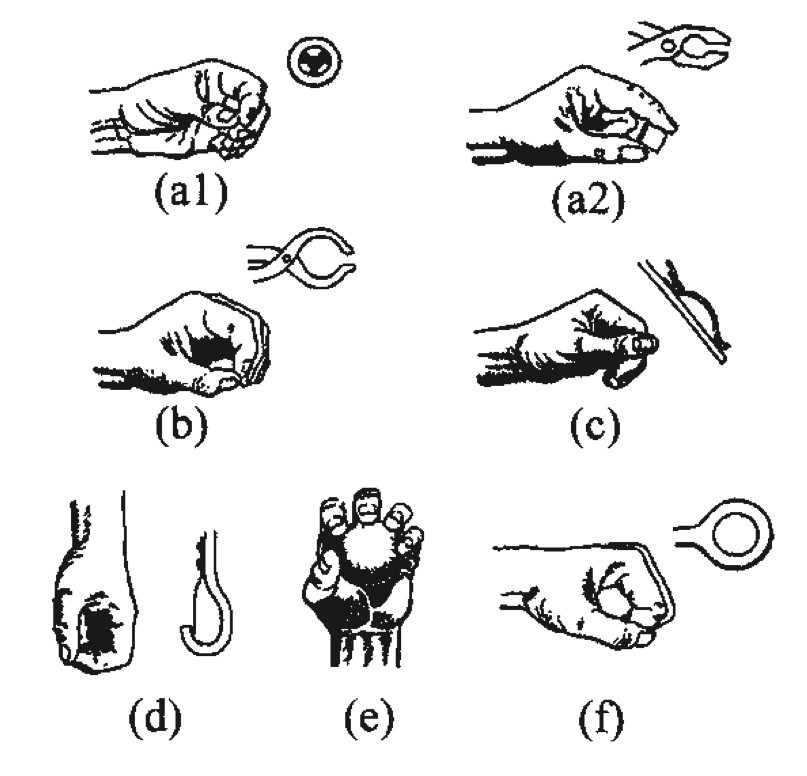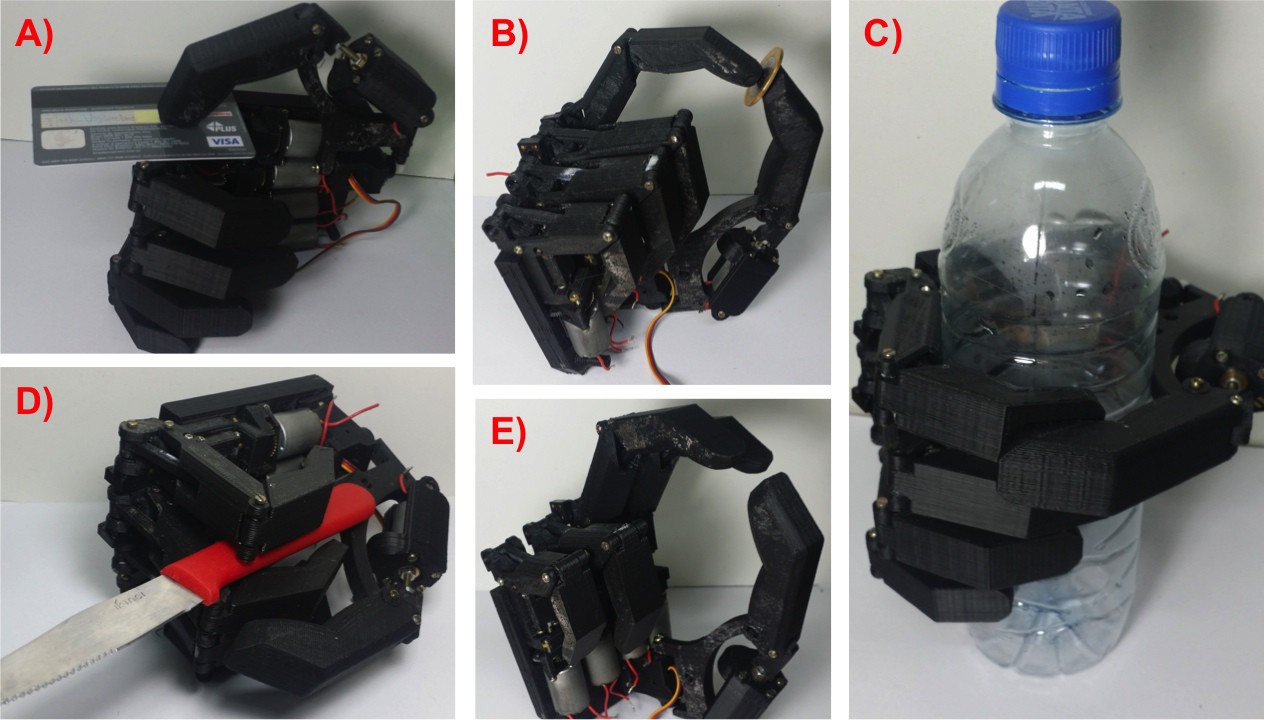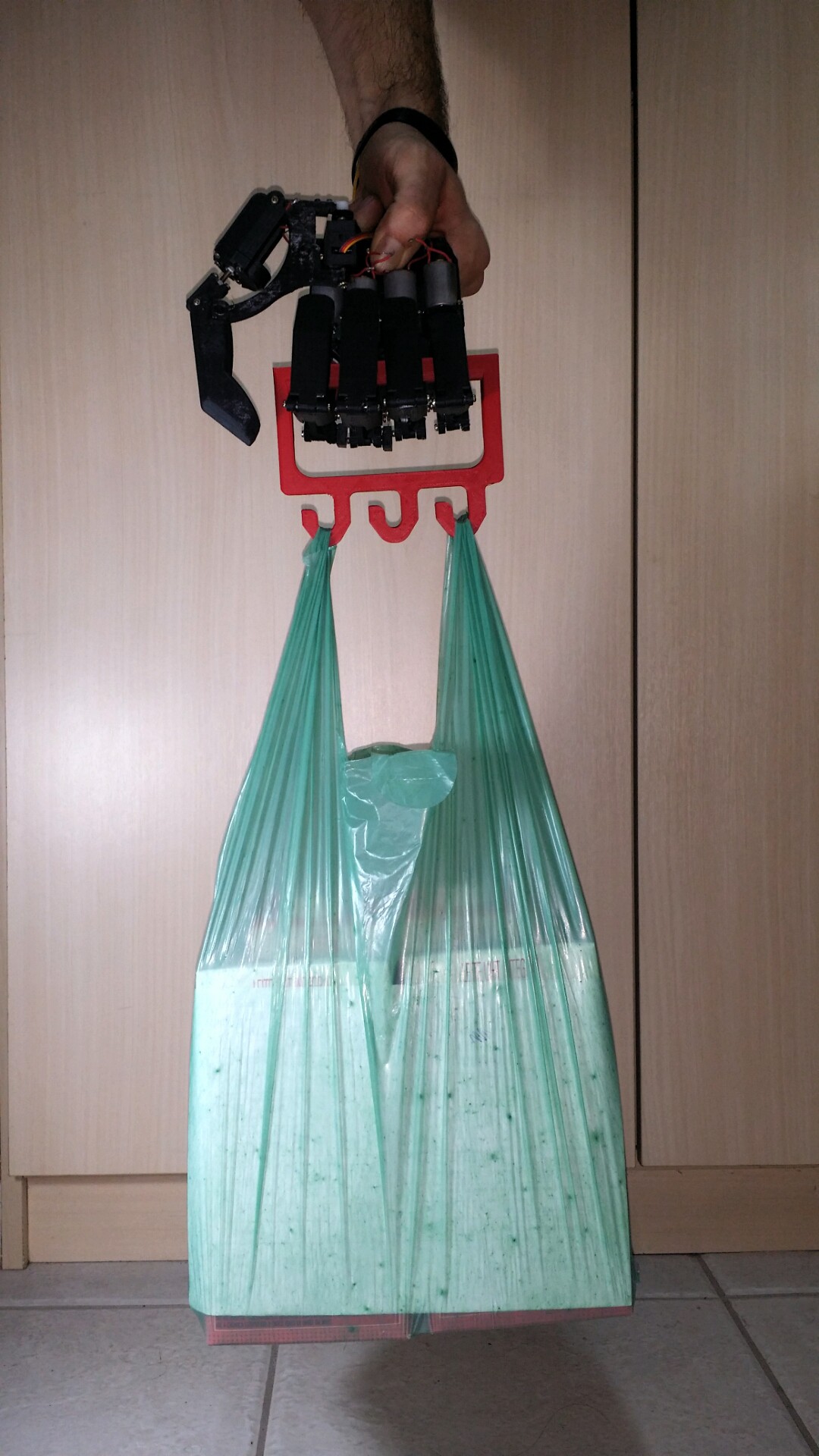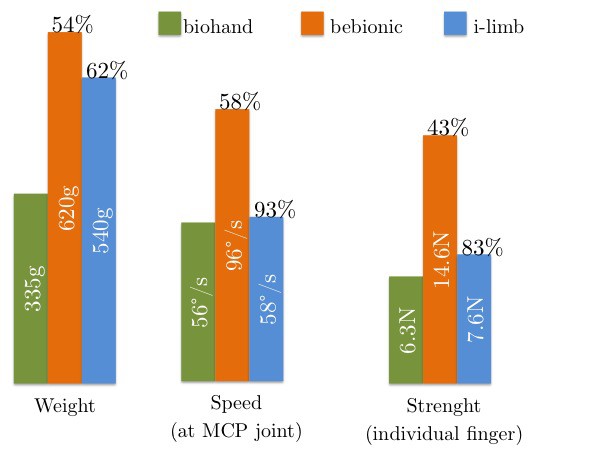As a part of my thesis on the biohand, I ran some relevant tests (mostly still with no control board, which came in a few days later). Some of these tests are presented briefly here. For more detail, check my thesis! :D
Prehensions
(Weir et al., 2003) presents a minimal list of required hand grips (prehensions) to accomplish the majority of the Activities of Daily Living (ADLs). This list encompasses a total of 7 different poses, shown below:

They are:
- a1) Tridigital palmar prehension (tripod grip)
- a2) Bidigital palmar prehension (pinch)
- b) Tip prehension
- c) Lateral grip
- d) Hook grip
- e) Spherical grip
- f) Cylindrical grip (power grip)
The image below shows the prototype's CAD model implementing this minimal set of prehensions (numbering is equivalent to the figure above):

With the 6 active Degrees of Freedom of the biohand, the list could be achieved with no problems. Following the CAD proof of concept, the poses were tested on the prototype itself. The image below shows some of the tested grips:

Those are:
- A) lateral grip
- B) bidigital palmar prehension
- C) cylindrical grip
- D) adduction grip: using the space/angle between adjacent fingers to hold thin objects.
- E) bidigital palmar prehension
Load test
It's a know fact that parts printed in an FDM 3D-printer have stronger bonds inside layers than between them (an interesting study shown here). All parts in the biohand take advantage of this fact: they are designed to be printed aligned to the printing bed in such a way, that the main stress and load gets distributed along the layers.
For example, the image below shows the proximal phalanx of the index finger. The red lines show were the phalanx connects to the MCP (metacarpophalangeal) and PIP (proximal interphalangeal) joints, as well as the linear actuator that moves the finger. The part gets printed with the orientation shown in the figure:

This grants an increased robustness. No destructive tests were conducted, but the test below shows the biohand succesfully whitstanding a load of 40N with no signs of demage:

The test was carried out with no power supply, since the fingers employ a non-backdrivable mechanism.
Speed, strenghts and weight
Upper-limb prosthetics still have a hard time achieving speeds and strenghts comparable to those in human arms and hands. To contextualize the biohand's streght, speed and weight, it shall be compared to two of the market-leading devices: the i-limb and the bebionic v2 (the previous version of the current v3 model). The data from these devices is based in the wok of (Belter et al., 2013):

The biohand weights in at approx. 335g (planned with the control board and cosmetic cover). This represents 54% and 62% of the the commercial prosthetics.
The index' angular speed, when measured at the MCP joint (at the base of the finger), reaches a peak of 56°/s, which is 58% and 93% of the other two devices.
Lastly, an individual finger of the biohand is capable of exerting up to 6.3N*, which represents 43% and 83% of the commercial devices.
Considering that the biohand uses modified RC servos as linear actuators for each finger, I can't say I'm not pleased with the results. Four fingers working simultaneously can exert more than 36N in a prehension. This is sufficient for the majority of lighter ADLs, as stated in (Smaby et al., 2004).
The reduction in weight is also very relevant. The work by (Pylatiuk et al., 2007) shows that excessive weight is a complaint of most amputees carrying some type of prosthetic device.
* The force test used only 60% of the biohand's nominal tension, to avoid motor demage during stall (for the maximum-force tests).
Cost
Lastly, one of the great thriumphs of the biohand is, in my opinion, its very low cost. With the prototype almost completed, the cost table can be calculated as follows:
| Item | Cost per unit (USD) | Quantity | Subtotal (USD) |
| Standard RC servo | 12,95 | 5 | 64,75 |
| Micro RC servo | 9,95 | 1 | 9,95 |
| Black ABS plastic (filament) | 19,19 (kg) | 155g | 2,97 |
| Other hardware costs (e.g., screws, glue) | - | - | 5,00 |
| STM32F103 processor | 7,14 | 1 | 7,14 |
| DRV8801 motor driver | 3,15 | 5 | 15,75 |
| Overall electronic costs (e.g., manufacturing) | - | - | 15,00 |
| 2S / 1000mAh LiPo battery | 11,49 | 1 | 11,49 |
| Total: | 132,05 |
Prices were checked in Amazon for the LiPo battery, in OSHPark for the board costs and in 3ders for the average spool price.
With a total price of approximately USD 132,05, the biohand costs 200 times less than the average commercial myoelectric/robotic prosthesis.
Bibliography
Weir, R. F. et al. Design Of Artificial Arms and Hands for Prosthetic Applications. 2003.
Belter, J. T. et al. “Mechanical design and performance specifications of anthropomorphic prosthetic hands: A review”. In: Journal of Rehabilitation Research & Development (2013).
Smaby, N. et al. “Identification of key pinch forces required to complete functional tasks”. In: Journal of Rehabilitation Research & Development (2004).
Pylatiuk, C., S. Schulz, and L. Döderlein. “Results of an Internet survey of myoelectric pros- thetic hand users”. In: Prosthetics and Orthotics International (2007).
 Martin Vincent Bloedorn
Martin Vincent Bloedorn
Discussions
Become a Hackaday.io Member
Create an account to leave a comment. Already have an account? Log In.